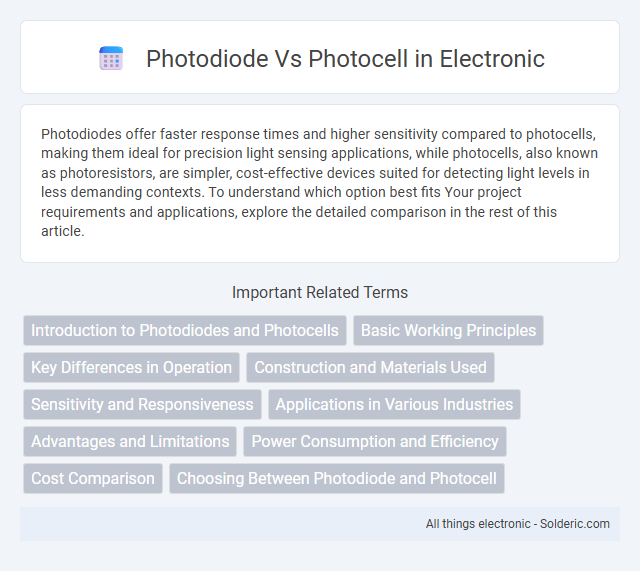Photodiodes offer faster response times and higher sensitivity compared to photocells, making them ideal for precision light sensing applications, while photocells, also known as photoresistors, are simpler, cost-effective devices suited for detecting light levels in less demanding contexts. To understand which option best fits Your project requirements and applications, explore the detailed comparison in the rest of this article.
Comparison Table
| Feature | Photodiode | Photocell (Photoresistor) |
|---|---|---|
| Operating Principle | Semiconductor junction that generates current when exposed to light | Resistive material whose resistance changes with light intensity |
| Response Time | Fast (nanoseconds to microseconds) | Slow (milliseconds to seconds) |
| Sensitivity | High sensitivity to light | Moderate sensitivity |
| Linear Output | Yes | No |
| Light Detection Range | UV to near-infrared spectrum | Visible light primarily |
| Typical Applications | Optical communication, light meters, safety equipment | Street lighting, alarm systems, light sensors |
| Power Consumption | Low | None (passive device) |
| Cost | Higher cost | Lower cost |
Introduction to Photodiodes and Photocells
Photodiodes are semiconductor devices that convert light into electrical current with high sensitivity and fast response times, making them ideal for precise light detection applications. Photocells, or photoresistors, change their resistance based on incident light intensity, often used in light-sensitive switching and dimming circuits due to their simplicity and cost-effectiveness. Key differences include photodiodes' ability to operate under reverse bias for faster and more linear response, whereas photocells rely on photoconductivity changes without the need for external voltage.
Basic Working Principles
Photodiodes convert light into electrical current using the photoelectric effect, generating electron-hole pairs when photons strike a semiconductor junction. Photocells, or photoresistors, alter their electrical resistance based on light intensity, relying on photoconductivity to control current flow. Your choice between the two depends on whether you need precise current output (photodiode) or a variable resistance response to light (photocell).
Key Differences in Operation
Photodiodes convert light into current by exploiting the photovoltaic effect, generating a rapid and linear response suitable for precise light measurement. Photocells, or photoresistors, change their electrical resistance based on light intensity, providing a slower, less linear response ideal for general light detection. The photodiode's semiconductor junction operates under reverse bias, enabling faster response times, whereas the photocell relies on the photoconductive effect within a semiconductor material without bias.
Construction and Materials Used
Photodiodes are semiconductor devices typically made from silicon or germanium, featuring a p-n junction that converts light into electrical current with high sensitivity and fast response. Photocells, or photoresistors, consist of a photosensitive material like cadmium sulfide (CdS) that changes resistance based on light intensity but respond slower and less precisely. Understanding these differences in construction and materials helps you choose the right sensor for applications requiring speed or light-dependent resistance.
Sensitivity and Responsiveness
Photodiodes exhibit higher sensitivity and faster responsiveness compared to photocells, making them ideal for precision light detection and rapid signal processing. Their semiconductor-based design allows for quick adaptation to changing light intensities, while photocells, typically made from photoresistive materials, respond more slowly and with less accuracy. Your choice depends on whether you prioritize rapid response speed or basic light sensing functionality.
Applications in Various Industries
Photodiodes are widely used in telecommunications for high-speed data transmission and in medical devices for precise optical sensing. Photocells, also known as photoresistors, find applications in outdoor lighting systems, automotive lighting controls, and solar garden lamps due to their light-sensitive resistance properties. Both components play crucial roles in consumer electronics, industrial automation, and environmental monitoring by converting light into electrical signals with varying sensitivity and speed.
Advantages and Limitations
Photodiodes offer faster response times and higher sensitivity to light compared to photocells, making them ideal for precision applications like optical communication and medical devices. Photocells, or photoresistors, are simpler and more cost-effective, with the ability to detect a broad range of light intensities but suffer from slower response and lower accuracy. Limitations of photodiodes include higher cost and complexity, while photocells are less reliable in varying temperature conditions and provide limited spectral sensitivity.
Power Consumption and Efficiency
Photodiodes exhibit significantly lower power consumption compared to photocells due to their semiconductor-based operation, making them ideal for energy-efficient applications. Your choice of photodiode ensures faster response times and higher sensitivity, resulting in enhanced efficiency for precise light detection. Photocells, while simpler and cost-effective, generally consume more power and offer slower response rates, which may reduce overall system efficiency.
Cost Comparison
Photodiodes generally offer a lower cost per unit compared to photocells, especially in high-volume production due to their semiconductor fabrication process. Photocells, or photoresistors, tend to be more affordable for simple, low-accuracy applications but may incur higher maintenance costs over time. Your choice depends on balancing initial investment against long-term performance and reliability requirements.
Choosing Between Photodiode and Photocell
Choosing between a photodiode and a photocell depends on your application's speed, sensitivity, and accuracy requirements. Photodiodes offer faster response times and higher sensitivity, ideal for precision optical measurements and communication devices. Photocells, or photoresistors, are cost-effective for ambient light detection and simple automation tasks where speed and precision are less critical.
photodiode vs photocell Infographic

 solderic.com
solderic.com